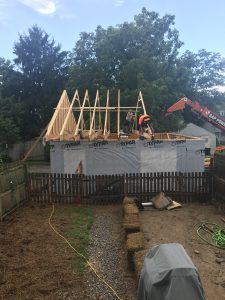Improving your land—by putting up an outbuilding, garage, workshop, or extending your driveway or patio, or any of a number of small projects—is a great way to enhance the enjoyment, utility, and resale value of your property. Many people have ideas about how they want to add to their property for a wide variety of reasons. Often, there are no issues with a proposed project, but sometimes it is necessary to be aware of local regulations that will bear on your ability to implement it. None of us likes to be restricted in what we may do on our property, but there are sometimes good reasons for certain limitations. Local zoning codes, noise ordinances, and homeowner association (HOA) restrictions are common ways that what we do may be constrained, for specific reasons. Understanding the relevant legal codes and limitations at your particular site is important to ensure a successful property improvement project.
Stormwater considerations you when alter your site

Projects we undertake on our properties often entail removal of grass, plants and other vegetative material, excavation and moving of quantities of dirt and soil, and laying down hard surfaces that do not allow water to infiltrate into the ground (called “impervious surfaces”). All of these can increase the amount of rainfall that runs off from your property, and can contribute to flooding elsewhere. In addition, any materials, such as soil/sediment, pesticides (insect spray and weed-killer), household and automotive wastes (like cleaning supplies or motor oil), and fertilizers (nutrients) can also wash off, causing pollution problems in the streams where the water eventually ends up.
Be a good neighbor
Anyone who has had water from their neighbor’s driveway flood their basement, or had mulch or soil wash into their yard or patio, knows what a problem stormwater runoff can be. Any building or land alteration nearby can have negative effects on neighbors and on neighboring waterways. Improving land is a good goal, but care must be taken to make sure any excess runoff or pollutants produced are handled correctly.
Whatever size project you may be planning, from a small shed to a major subdivision, must take into consideration the effects on neighbors and others “downstream”. Proper planning is therefore critical to ensuring a safe, legal, and successful development project.
Click here for an example of how one suburban developer approached the challenge. This two-page summary offers a quick introduction to stormwater issues facing the construction industry.
From the standpoint of code requirements, many land improvement projects are classified by amount of disturbed area. Different municipalities have different thresholds for what size (in square feet of disturbed land) projects are required to address stormwater considerations. You must check your local municipality and all other governing entities to determine your responsibility for following stormwater and all other regulations.
Each stage of development from planning through future maintenance should be considered up front. Stormwater control should be considered at 4 separate stages:
- Planning for runoff
- Controlling runoff during construction
- Controlling runoff in completed project
- Long-term maintenance of runoff control
Always check with your municipality to determine whether your construction project requires a building permit or submission of a land development plan.
1. Planning for runoff
For many projects a professional landscape architect, engineer or planner is needed to develop a stormwater management plan for your project that meets state and local stormwater codes. Successful implementation of the plan is also critical to ensure that structures are installed correctly by knowledgeable contractors for success and ensure that BMP’s are working properly as designed, and fulfill all regulatory requirements.
For a list of local designers and contractors, you may contact contact Chester County Conservation District at (610) 455-1360.
Some things to consider when planning a home improvement or development:
- What is the size of the increased impervious area?
- Is a stormwater plan needed for this size project?
- Is a construction permit required?
- Is the project located in a flood plain, riparian stream buffer or other protected area? (Check your local ordinance for specific requirements.)
To learn more, check out this Green Stormwater Infrastructure Guide.
2. Controlling runoff during construction
Management of runoff from disturbed land during the construction process, called Excavation and Sedimentation (E&S) controls, is a critical stormwater projects. Removing vegetative cover, excavation and other construction-related activities can result in up to 1000 times the stormwater runoff relative to undisturbed land. That runoff is often loaded with soil and sediment, and can cause significant erosion and downstream pollution.
If you are disturbing over 5000 square feet (just under an eighth of an acre), you will need to file an E&S plan with the conservation district and may have responsibilities under your municipality’s stormwater ordinance. If the project disturbs less than 5000 square feet, you will still want to take E&S precautions and inspect the site for potential problems following downpours or other weather events. See suggestions in the Homeowner’s Guide to Stormwater or Stormwater Pollution Prevention for Small Residential Construction Sites
3. Controlling runoff in completed project
Post-construction stormwater management (PCSM) is sometimes required in larger development projects. This means that some sort of system to manage stormwater (to keep it from running off the property, or minimizing its effects) might be necessary. This can be achieved through the installation of control structures such as ponds, pipes, culverts, and swales, or implementation of “Best Management Practice” (BMP) elements to help control and reduce runoff and related pollution. These can include bio-retention basins (like rain-gardens), infiltration trenches, diversions, rain-barrels, or downspout diversions, among many others.
If your project adds more than 1000 square feet of impervious surface, then your construction plan will need to include a stormwater management systems (i.e., BMPs) designed to capture stormwater runoff as specified in your municipality’s stormwater management ordinance Even for smaller projects you should still consider how to control the impacts of stormwater runoff. New construction is an excellent opportunity to add or improve stormwater BMPs to reduce the runoff from your property.
Ultimately, you as the landowner are responsible for ensuring that the BMP is properly installed and stormwater issues adequately addressed. This video provides a helpful overview of some of the challenges involved.
4. Long-term maintenance of runoff control
To ensure that stormwater control in your project remains effective over time, it is important to establish a plan for Operations and Maintenance (O&M). All stormwater control systems require on-going maintenance. This may involve activites such as controlling weeds and other overgrowth, ensuring drains are cleaned out, repairing leaking pipes, or digging out sediment from ponds.
You may need to ask the contractor installing your stormwater BMP to provide you with O&M documentation and the training needed to understand your responsibilities. Store the O&M guidelines in a safe place and add necessary inspections to your calendar. If BMPs are to be managed by a homeowners association (HOA), then the HOA needs to ensure that those O&M guidelines are readily available and followed. Failure by the contractor to provide adequate guidelines does not eliminate your responsibility for ensuring that the BMP is operating properly. Helpful resources in this situation include:
- Homeowners Guide to Stormwater BMP Maintenance
- Maintaining Stormwater Basins
- Landowner Guide to Buffer Success
The following links introduce some of the relevant state and federal guidelines that relate to stormwater control in local projects in Chester County.
You can also get many questions answered by contacting the
Chester County Water Resources Authority at 610-344-5400, or the
Chester County Conservation District at 610-455-1360.
Chapter 102 of the PA Code sets out the responsibilities for property owners, construction contractors and developers to manage stormwater runoff during and after construction (including single family residential, multi-family housing, mixed use, commercial, industrial, new construction for agricultural operations).
The PA Stormwater Management Act 167 requires that projects that will disturb less than one acre be reviewed by the municipality or through the Chester County Conservation District. Post Construction Stormwater Management (PCSM) for projects under an acre is also regulated through the municipality through a grading permit or subdivision and land development application. Projects applying under these programs are reviewed for compliance with the municipality’s stormwater management ordinance. Municipal stormwater management ordinances are at least as stringent as the County’s Act 167 Model Ordinance, which satisfies all requirements in DEP’s statewide model ordinance.
US EPA regulations under the Clean Water Act require that projects that will disturb more than one acre over the course of the project have a National Pollutant Discharge Elimination System (NPDES) Permit. This permit is intended to ensure that all Chapter 102 regulations are being met for the construction activities during (E&S) and after construction (PCSM). For the NPDES Construction Stormwater permit, the developer is the responsible party (as opposed to the NPDES MS4 permit for which the municipality is responsible).
PA DEP issues NPDES Permits pursuant to a legal delegation from the US EPA, and then most County Conservation Districts, including Chester County, have a delegation agreement with PA DEP for some or all of the NPDES Reviews. Similar to MS4 permits, the applicant can apply under either a General NPDES Construction Stormwater Permit (PAG-02) or an Individual Permit. An Individual Permit is required for projects located in special protection (HQ or EV) waters or for projects that do not meet the eligibility criteria for the PAG-02. There are additional requirements for NPDES Permitted Projects in special protection watersheds, including Antidegradation implementation requirements under Chapter 93 of the PA Code and riparian buffer requirements. Additional resources for residents or developers on the NPDES Construction Stormwater Permits can be found here.

